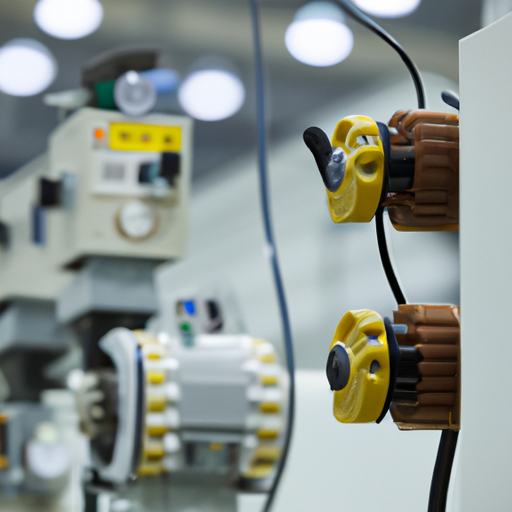

Title: The Mainstream Relay Production Process: A Comprehensive Overview

1. Design and Development (200 words) The relay production process begins with the design and development phase. Engineers work closely with product managers and customers to identify the specific requirements and functionalities of the relay. This phase involves creating detailed schematics, selecting appropriate materials, and determining the relay's physical dimensions.
2. Material Selection (150 words) Once the design is finalized, the next step is selecting the materials for the relay's components. Relays typically consist of a coil, contacts, and a housing. The coil is usually made of copper wire, while the contacts can be made of various materials, including silver, gold, or alloys. The housing is commonly made of plastic or metal, depending on the relay's application and environmental conditions.
3. Manufacturing of Components (250 words) After material selection, the manufacturing of individual relay components begins. Copper wire is wound to create the coil, which is then mounted onto a bobbin. The contacts are fabricated separately, often through stamping or machining processes. These components undergo rigorous quality checks to ensure they meet the required specifications.
4. Assembly (200 words) The assembly phase involves combining the various components to create a functional relay. The coil is placed onto the bobbin, and the contacts are carefully positioned. The housing is then assembled, enclosing the coil and contacts securely. This step requires precision and attention to detail to ensure proper alignment and functionality.
5. Testing and Quality Control (250 words) Once the relay is assembled, it undergoes rigorous testing and quality control measures. This includes electrical testing to verify the coil's resistance, contact resistance, and insulation resistance. Mechanical tests are conducted to assess the relay's durability, such as endurance testing to simulate real-world usage conditions. Additionally, environmental tests are performed to evaluate the relay's performance under extreme temperatures, humidity, and vibration.
6. Packaging and Distribution (150 words) After passing all quality control tests, the relays are packaged and prepared for distribution. Packaging typically involves placing the relays in protective containers or trays to prevent damage during transportation. Proper labeling and documentation are essential to ensure traceability and ease of identification for customers.
Conclusion (100 words) The mainstream relay production process involves several crucial steps, from design and material selection to manufacturing, assembly, testing, and packaging. Each stage requires meticulous attention to detail and adherence to strict quality control measures. By understanding this process, manufacturers and engineers can ensure the production of reliable and high-quality relays that meet the diverse needs of various industries.
Title: The Mainstream Relay Production Process: A Comprehensive Overview

1. Design and Development (200 words) The relay production process begins with the design and development phase. Engineers work closely with product managers and customers to identify the specific requirements and functionalities of the relay. This phase involves creating detailed schematics, selecting appropriate materials, and determining the relay's physical dimensions.
2. Material Selection (150 words) Once the design is finalized, the next step is selecting the materials for the relay's components. Relays typically consist of a coil, contacts, and a housing. The coil is usually made of copper wire, while the contacts can be made of various materials, including silver, gold, or alloys. The housing is commonly made of plastic or metal, depending on the relay's application and environmental conditions.
3. Manufacturing of Components (250 words) After material selection, the manufacturing of individual relay components begins. Copper wire is wound to create the coil, which is then mounted onto a bobbin. The contacts are fabricated separately, often through stamping or machining processes. These components undergo rigorous quality checks to ensure they meet the required specifications.
4. Assembly (200 words) The assembly phase involves combining the various components to create a functional relay. The coil is placed onto the bobbin, and the contacts are carefully positioned. The housing is then assembled, enclosing the coil and contacts securely. This step requires precision and attention to detail to ensure proper alignment and functionality.
5. Testing and Quality Control (250 words) Once the relay is assembled, it undergoes rigorous testing and quality control measures. This includes electrical testing to verify the coil's resistance, contact resistance, and insulation resistance. Mechanical tests are conducted to assess the relay's durability, such as endurance testing to simulate real-world usage conditions. Additionally, environmental tests are performed to evaluate the relay's performance under extreme temperatures, humidity, and vibration.
6. Packaging and Distribution (150 words) After passing all quality control tests, the relays are packaged and prepared for distribution. Packaging typically involves placing the relays in protective containers or trays to prevent damage during transportation. Proper labeling and documentation are essential to ensure traceability and ease of identification for customers.
Conclusion (100 words) The mainstream relay production process involves several crucial steps, from design and material selection to manufacturing, assembly, testing, and packaging. Each stage requires meticulous attention to detail and adherence to strict quality control measures. By understanding this process, manufacturers and engineers can ensure the production of reliable and high-quality relays that meet the diverse needs of various industries.